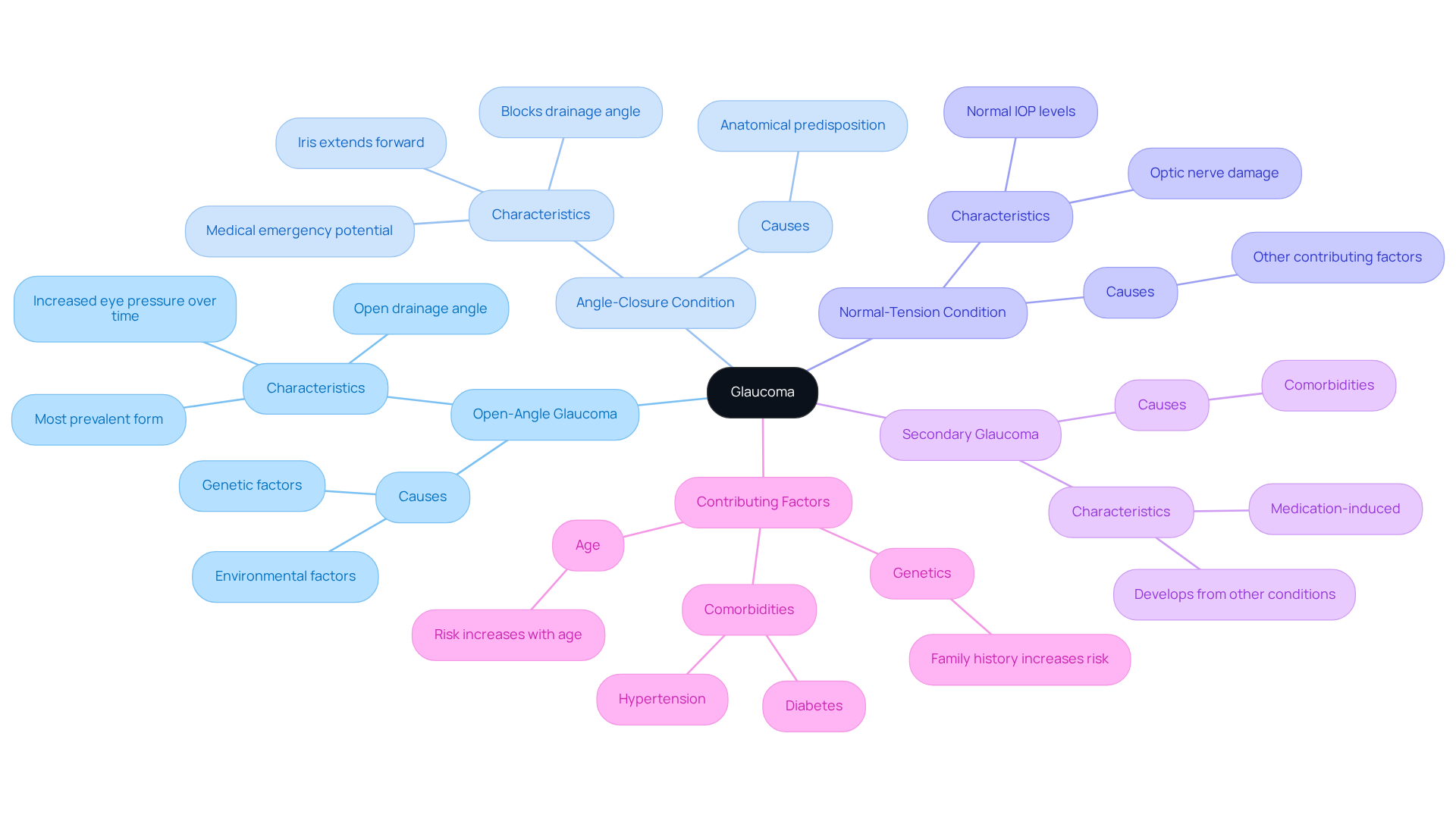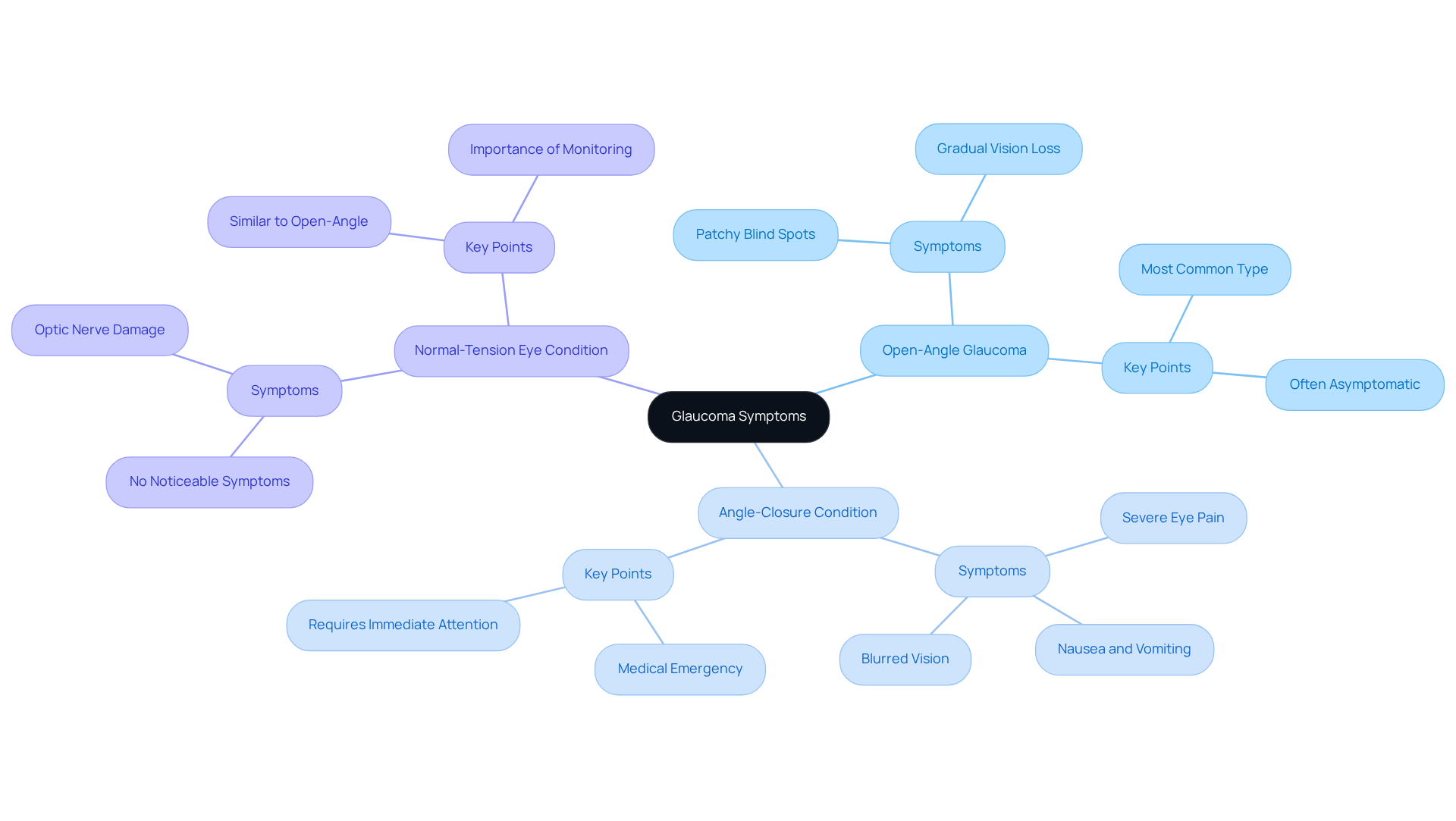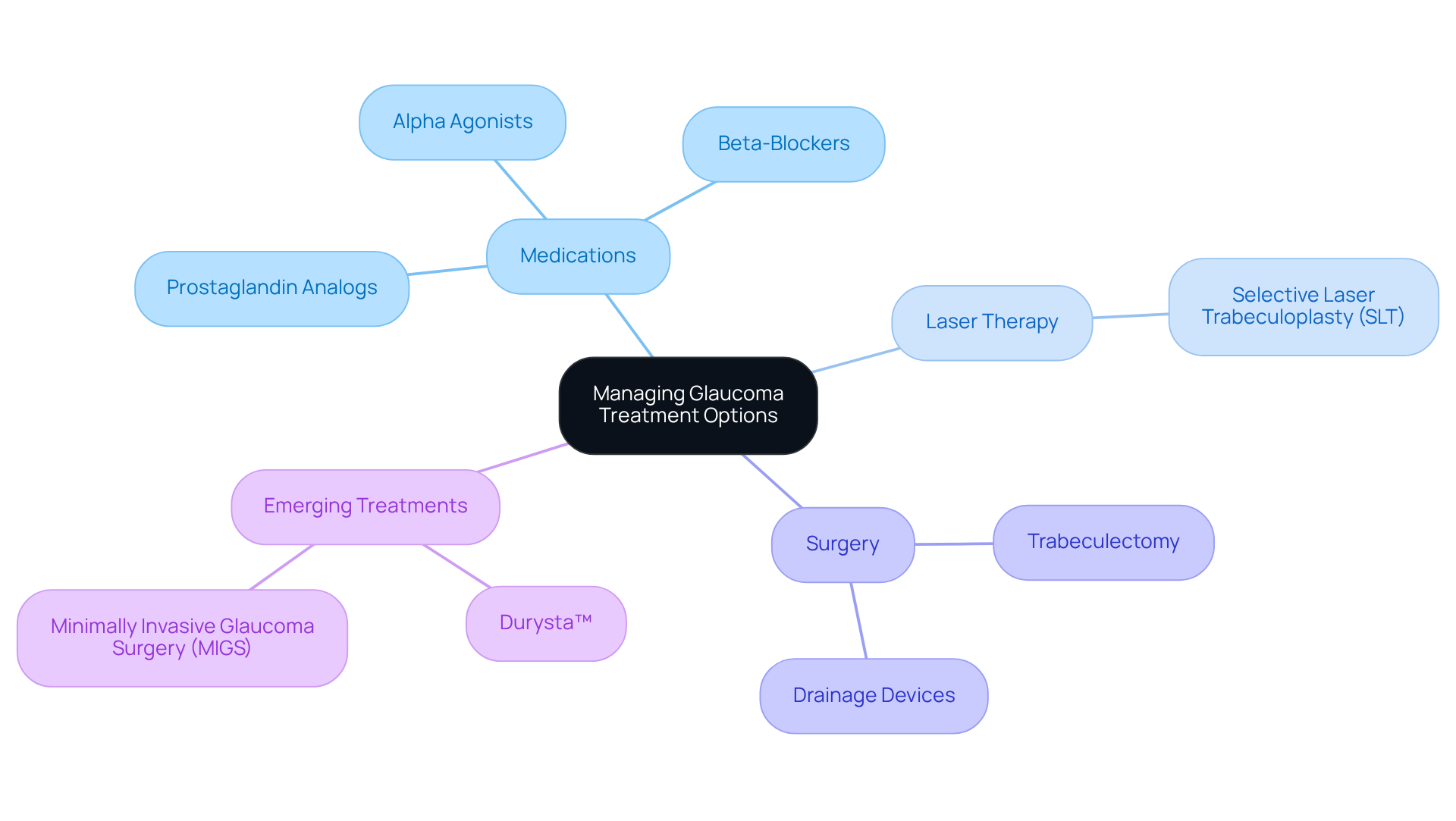Posted by: Northwest Eye in General, Glaucoma on August 19, 2025
Overview
Glaucoma vision is often marked by various eye disorders that can harm the optic nerve, primarily due to increased intraocular pressure. We understand that this can be concerning, especially since it can lead to significant vision loss if not detected and treated early. This article emphasizes the importance of understanding the types, symptoms, and treatment options for glaucoma.
- Regular eye exams
- Proactive management
can significantly reduce the risk of irreversible vision loss. It’s important to note that nearly half of those affected are unaware of their condition, which can be alarming. We are here to help you through this process and encourage you to seek care.
Introduction
Understanding glaucoma is crucial for maintaining eye health, especially as this condition silently threatens vision worldwide. We understand that the thought of potential vision loss can be distressing. With projections indicating that millions will be affected by various forms of glaucoma in the coming years, it is vital to recognize symptoms and explore treatment options.
How can individuals navigate the complexities of this ‘silent thief of sight’ and ensure they are equipped to manage their eye health effectively? This article delves into the types, causes, symptoms, and treatment strategies for glaucoma, empowering you with the knowledge needed to combat this pervasive issue. We are here to help you through this process.
Define Glaucoma: Types and Causes
This condition encompasses various eye disorders that can harm the optic nerve, primarily due to increased intraocular tension, which is crucial in understanding glaucoma vision. We understand that navigating this topic can be concerning, so let’s explore the main types of glaucoma together:
- Open-Angle Glaucoma: This is the most prevalent form, characterized by an open drainage angle that fails to adequately drain fluid, resulting in increased eye pressure over time.
- Angle-Closure Eye Condition: This type occurs when the iris extends forward, blocking the drainage angle and possibly leading to a swift increase in ocular tension, which can be a medical emergency.
- Normal-Tension Condition: In this variant, optic nerve damage occurs even when IOP remains within normal ranges, indicating that other factors may contribute to nerve damage.
- Secondary Glaucoma: This form develops as a consequence of other medical conditions or medications that elevate eye pressure.
The factors contributing to this eye condition are multifaceted, often influenced by genetic predispositions, advancing age, and comorbidities such as diabetes and hypertension. It’s common to feel overwhelmed by these statistics, but understanding them can empower you. For example, studies show that people with a familial background of eye disease encounter a notably increased risk, with projections indicating a rise of up to 2.85 times. Moreover, the incidence of open-angle eye disease is anticipated to increase, with around 76 million individuals impacted worldwide by 2040, and the overall count of people with this condition expected to hit 112 million by 2040.
Comprehending the different forms and root causes of glaucoma vision is essential for early identification and efficient management. Routine eye assessments, including dilated tests, are vital for detecting conditions like glaucoma vision, particularly as almost half of those affected in the U.S. are unaware of their condition. As noted by Lisa M. Young, OD, FAAO, “Regular eye exams not only keep your vision sharp but also detect signs of systemic health conditions like diabetes and high blood pressure.” We are here to help you through this process; proactive awareness and education about eye disease can significantly enhance patient outcomes and reduce the risk of vision loss.
Furthermore, socioeconomic factors can influence access to eye care, emphasizing the necessity for focused public health initiatives. Case studies on angle-closure eye conditions management illustrate the importance of timely treatment to prevent severe complications. By addressing these factors, we can enhance the overall management of this condition and its effect on individuals’ lives.

Identify Symptoms: Recognizing Glaucoma’s Impact on Vision
Symptoms of glaucoma can vary significantly depending on the type and stage of the disease. It’s essential to recognize these symptoms early, as they can greatly impact your vision.
-
Open-Angle Glaucoma: This form often goes unnoticed in its early stages. However, it may eventually lead to patchy blind spots in your peripheral vision. We understand that the thought of losing sight can be frightening, which is why regular eye exams are crucial to catch any changes early.
-
Angle-Closure Condition: This type can arise suddenly, presenting severe eye pain, headaches, nausea, vomiting, and blurred vision. If you experience these symptoms, it’s important to seek immediate medical attention to prevent irreversible damage.
-
Normal-Tension Eye Condition: Like open-angle glaucoma, this condition may not show noticeable symptoms until significant optic nerve damage has occurred. This highlights the importance of proactive monitoring, as we know how concerning it can be to face potential health issues without clear signs.
Identifying these symptoms promptly is vital, as glaucoma vision changes are often referred to as the ‘silent thief of sight’ due to its gradual progression without obvious warning signs. Regular eye exams are essential for early detection, especially for those at higher risk, such as individuals over 60 or those with a family history of the disease. Research indicates that around 50% of people with glaucoma are unaware of their condition, emphasizing the need for awareness and regular screenings.
Moreover, glaucoma accounts for 9% to 12% of blindness globally, underscoring the importance of recognizing symptoms early. With the economic burden of this condition projected to exceed $19 billion each year by 2040, early detection is not only vital for your health but also for alleviating broader economic impacts. We recommend baseline screenings by age 40 to ensure proactive eye health measures. Remember, we are here to help you through this process.

Review Treatment Options: Managing Glaucoma Effectively
Effectively managing glaucoma vision requires a tailored approach that considers your unique needs. We understand that dealing with glaucoma vision can be challenging, and we are here to help you through this process. Common treatment options include:
-
Medications: Prescription eye drops are typically the first line of defense against elevated intraocular pressure (IOP). These may consist of prostaglandin analogs, beta-blockers, and alpha agonists. It’s important to know that adherence rates can vary among patients, often influenced by side effects and the complexity of regimens.
-
Laser Therapy: Procedures such as selective laser trabeculoplasty (SLT) can significantly improve fluid drainage from the eye, resulting in decreased tension. Research shows that patients receiving SLT experience a 29% slower advancement of the eye condition compared to those relying solely on eye drops. In fact, only 14 percent of eyes in the laser group exhibit rapid progression (faster than -0.5 dB/year), compared to 25 percent in the eye drop group. This highlights the effectiveness of SLT as a first-line treatment.
-
Surgery: When medications and laser treatments fail to adequately control IOP, surgical interventions such as trabeculectomy or the implantation of drainage devices may be necessary. These procedures aim to create new pathways for fluid drainage, lowering IOP more effectively.
-
Emerging Treatments: Innovations in managing glaucoma include sustained-release drug delivery systems, such as Durysta™, a long-term biodegradable eye implant approved for reducing eye pressure, and minimally invasive surgeries (MIGS). These advancements are designed to improve treatment efficacy while enhancing your comfort and compliance.
Regular follow-ups with your eye care specialist are essential for monitoring your glaucoma vision and adjusting treatment plans as needed. We understand that this proactive approach not only helps in managing glaucoma vision effectively but also empowers you to take an active role in your eye health.

Conclusion
Understanding glaucoma is essential for safeguarding your vision, as this condition poses a significant threat to eye health globally. We understand that navigating the complexities surrounding glaucoma can be daunting, but by recognizing these challenges, you can take proactive steps to monitor your eye health and seek timely intervention. The insights provided aim to empower you with knowledge about the condition, its symptoms, and the available treatments.
Key points discussed include the various types of glaucoma, such as open-angle and angle-closure glaucoma, along with their respective causes and symptoms. It’s common to feel overwhelmed by the importance of early detection through regular eye exams, especially given the alarming statistics regarding unawareness among those affected. Treatment options, ranging from medications and laser therapy to surgical interventions, highlight the necessity of tailored approaches to effectively manage intraocular pressure and preserve your vision.
Ultimately, understanding glaucoma is not just about individual health; it encompasses broader public health implications as well. As the incidence of glaucoma is projected to rise, fostering awareness and accessibility to eye care services is crucial. We encourage you to prioritize regular eye examinations and stay informed about advancements in treatment options. By doing so, you can actively participate in safeguarding your vision against this ‘silent thief of sight.
Frequently Asked Questions
What is glaucoma?
Glaucoma is a group of eye disorders that can damage the optic nerve, primarily due to increased intraocular pressure (IOP), which is critical to understanding glaucoma vision.
What are the main types of glaucoma?
The main types of glaucoma include: – Open-Angle Glaucoma: The most common form, where an open drainage angle fails to drain fluid effectively, leading to increased eye pressure over time. – Angle-Closure Glaucoma: Occurs when the iris blocks the drainage angle, potentially causing a rapid increase in ocular tension, which can be a medical emergency. – Normal-Tension Glaucoma: Optic nerve damage occurs even with normal IOP levels, suggesting other contributing factors. – Secondary Glaucoma: Develops due to other medical conditions or medications that raise eye pressure.
What factors contribute to the development of glaucoma?
Contributing factors include genetic predispositions, advancing age, and comorbidities such as diabetes and hypertension.
How significant is the risk of glaucoma for individuals with a family history of eye disease?
Individuals with a familial background of eye disease face a significantly increased risk, with projections indicating a rise of up to 2.85 times.
What is the projected incidence of open-angle glaucoma by 2040?
It is estimated that around 76 million individuals will be affected by open-angle glaucoma worldwide by 2040, with the total number of people with glaucoma expected to reach 112 million.
Why are routine eye assessments important for glaucoma detection?
Routine eye assessments, including dilated tests, are crucial for detecting glaucoma, as nearly half of those affected in the U.S. are unaware of their condition.
What role do socioeconomic factors play in glaucoma management?
Socioeconomic factors can influence access to eye care, highlighting the need for public health initiatives to improve access and management of glaucoma.
How can timely treatment affect angle-closure glaucoma?
Timely treatment of angle-closure glaucoma is essential to prevent severe complications, as illustrated by case studies on its management.






